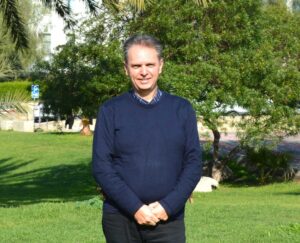The Universal Language of Mathematics: Exploring Its Boundless Applications
Mathematics, often described as the universal language, has the unique ability to bridge abstract theory and practical applications.

In this interview, Prof. Hınçal reflects on his journey in mathematics, the interdisciplinary applications of his work, and his advice to young researchers aspiring to make their mark in this field.
How did you decide to pursue a career in mathematics? Were there any key individuals or events that influenced you?
My father was the primary influence behind my decision to pursue mathematics. As a teacher, he recognized my interest in numbers and analytical thinking early on, which significantly shaped my career choices. Later, my professors at Hacettepe University inspired me further with their expertise and passion for mathematics.
Mathematics has always fascinated me with its logical structure and theorems. It is the only scientific field where proofs exist, making it uniquely rigorous and satisfying. Additionally, mathematics has taught me patience and resilience. Spending hours solving complex problems and experiencing the joy and confidence that comes with finding solutions are invaluable feelings. These experiences motivated me to dedicate my career to mathematics and share this passion with others.
“Mathematics is more than numbers; it teaches patience, resilience, and the joy of problem-solving.”
What are your thoughts on the applications of mathematics in different disciplines? How does your work interact with other fields?
Mathematics is the cornerstone of modern society, playing a vital role in fields ranging from science and engineering to economics, art, and medicine. Mathematical concepts and methods are used to understand and solve problems across these disciplines, serving as a bridge between theoretical mathematics and practical applications.
In science, mathematics is indispensable for creating theoretical models and interpreting observations. For instance, Newton’s laws of motion rely on differential equations, which are fundamental for modeling and predicting the movement of objects. Similarly, in biology, mathematical models are used in population dynamics, epidemiology, and genetic engineering.
“Mathematics bridges the gap between theory and practice, impacting almost every aspect of life.”
Engineering heavily relies on mathematics for design and optimization processes, while economics and finance use mathematical analysis to model markets, predict trends, and manage risks. Even art and music benefit from mathematical principles, such as geometry in visual balance or the mathematical structure underlying musical harmony.
In your career, which research projects have been the most significant or impactful for you?
Two research projects stand out in my career. The first was during my master’s studies, focusing on the dynamics of Bovine Spongiform Encephalopathy (BSE), also known as mad cow disease. Using mathematical modeling, I analyzed its transmission pathways and societal impacts, developing strategies to control its spread. This work provided critical insights for veterinary and public health policies.

“Integrating mathematics and medicine has the potential to revolutionize cancer treatment through precision and personalization.”

My current project focuses on understanding and modeling the progression of Alzheimer’s disease. By using differential equations and stochastic processes, I am simulating the accumulation of amyloid-beta plaques and tau proteins in the brain and their impact on neural damage.
“Mathematical models provide a deeper understanding of Alzheimer’s disease and the potential to optimize treatment strategies.”
Future goals include developing more precise and personalized treatments for Alzheimer’s using artificial intelligence and machine learning. I also aim to create advanced mathematical models for early diagnosis, which could significantly improve patient outcomes.

First and foremost, building a strong foundation in mathematical thinking is crucial. Mastering fundamental concepts and theories will provide the tools necessary for tackling complex problems later on. It is equally important to understand that mathematics is not just an abstract discipline but a practical tool for solving real-world problems.
“A strong foundation in mathematical thinking is the key to unlocking its vast potential.”
Secondly, patience and perseverance are essential. Mathematical problem-solving can be time-consuming and challenging, but every obstacle offers an opportunity to learn and grow. Lastly, be open to collaboration and interdisciplinary work. Mathematics interacts with countless fields, and engaging with other disciplines can open new doors and perspectives.
Who is Prof. Dr. Evren Hınçal?
Evren Hınçal was born in Nicosia in 1973. He completed his undergraduate studies in the Department of Mathematics at Hacettepe University and earned his master’s degree with distinction from the University of London, Imperial College. His Ph.D. was a collaborative program between the Department of Biology at Imperial College and the Department of Mathematics at Eastern Mediterranean University.
Since 2007, he has served as a full-time faculty member in the Department of Mathematics at Near East University, where he was appointed Professor in 2018. He currently holds multiple leadership roles, including Vice Dean of the Faculty of Arts and Sciences, Head of the Department of Mathematics, and President of the Mathematics Research Center, which he founded in 2018. In May 2023, Prof. Hınçal was awarded the “Dr. Suat İrfan Günsel Golden Medal of Honor” for his significant contributions to science.
His research focuses on mathematical modeling in areas such as cancer statistics, epidemiology, and infectious diseases, with numerous publications in respected international journals. As of August 2023, he also serves as Chair of the Excellence Center and Advisor to the Board of Trustees of the Near East Formation.